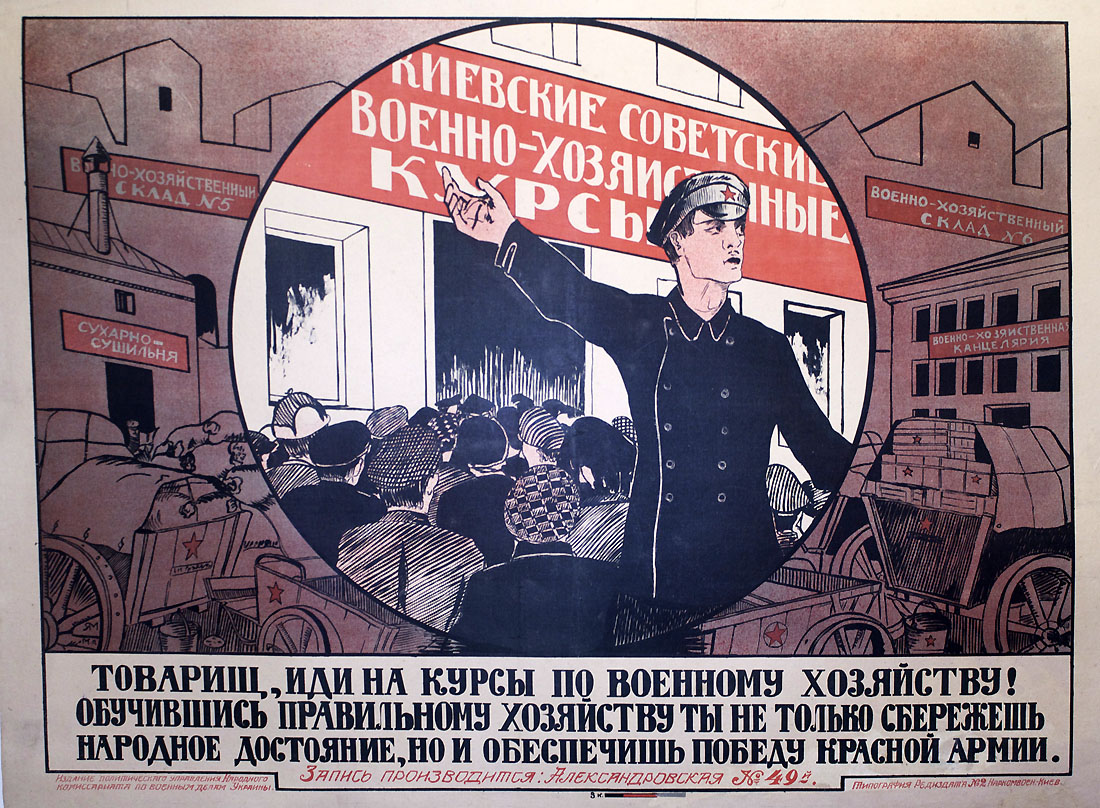
Comrade, attend the Military-Industry course! Once you have studied the proper procedures, you will not only save people’s property but you will also ensure the victory of the Red Army. Enrollment at 49 Aleksandrovskaia Street.
Poster Number: PP 430
Category: Civil War
Poster Notes:
[In circle behind army cadet]
“Kiev Soviet Military-Industrial Courses”
[On buildings in the background]
Military-Industrial Warehouse No. 5
Drying of Bread
Military-Industrial Warehouse No. 6
Military-Industrial Office
[On the bread carts are names of regions]
Media Size: 32.5x25
Poster Type: Lithograph
Publishing Date: c.1919
Technical Information on Poster: Publication of the Political Directorate of the National Commissariat on Military Affairs, Ukraine
Print Run: 10,000
Sources & Citation: Soviet Posters of the era of the Civil War 1918-1921 by B.S. Butnik-Siverskii (1960), page 317, poster 1743
Catalog Notes: PP 430 Civil War b
Artist: Ia.M. — Я.М.
These initials might refer to the artist Mikhail Nikolaevich Iakovlev. See Iakovlev, Mikhail Nikolaevich.
Read More About This Artist
Artist: M.P. — М.П.
Printer: Redizdat (Editorial and Publishing Department) — Редиздат (Редакционно-издательский отдел)
Redizdat (Editorial and Publishing Department) was established in 1921 by a decision of the Third Congress of the Communist International. It reported to the secretariat of the International’s Executive Committee. Redizdat was created to establish printing and publishing outlets in Soviet-controlled zones during the Russian Civil War. For example, the Ukrainian branch of Redizdat in concert with Narkomvoen (People's Commissariat for Military Affairs) printed over six million propaganda leaflets. By 1935, Redizdat was dissolved. In 1937, the en...
Read More About This Printer
Publisher: Political Directorate of the Military Region [Ukraine] — Политуправление Военного округа [Украина]
The Military Region of Ukraine was formed during the Ukrainian-Soviet War that was fought from 1917 until 1921. The war was a conflict for the control of Ukraine and it was fought between Ukrainian nationalists and Polish-Ukrainian forces against pro-Bolshevik Ukrainians and Soviet-backed Russians. The Second Winter Campaign of 1921 (of the Russian Civil War) is generally recognized as the end of the Ukrainian-Soviet conflict. Historically, military regions came about during the Imperial Tsarist period to administer military ...
Read More About This Publisher